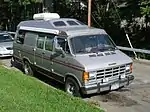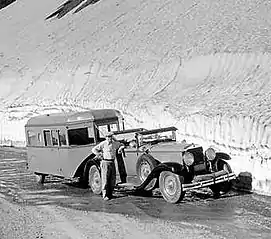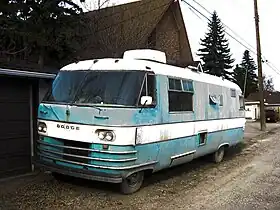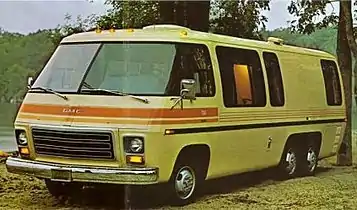
A recreational vehicle, often abbreviated as RV, is a motor vehicle or trailer that includes living quarters designed for accommodation.[1] Types of RVs include motorhomes, campervans, coaches, caravans (also known as travel trailers and campers), fifth-wheel trailers, popup campers, and truck campers.

Features

Typical amenities of an RV include a kitchen, a bathroom, and one or more beds.[2] RVs can range from utilitarian – containing only sleeping quarters and basic cooking facilities – to luxurious, with features like air conditioning (AC), water heaters, televisions and satellite receivers, and quartz countertops, for example.
RVs can either be trailers (which are towed behind motor vehicles) or self-propelled vehicles. Most RVs are single-deck; however, double-deck RVs also exist. To allow a more compact size while in transit, larger RVs often have expandable sides (called slide-outs) or canopies that are deployed when stationary.
| Name | Image | Type | Length | Description |
|---|---|---|---|---|
| Camper or Travel trailer |  |
Trailer | 13 to 35 ft (4.0 to 10.7 m) | Uses tow hitch attached to rear frame of towing vehicle |
| Fifth wheel |  |
Trailer | 17 to 40 ft (5.2 to 12.2 m) | Uses fifth-wheel coupling centered above rear axle of towing vehicle |
| Folding / Pop-up |  |
Trailer | 8 to 16 ft (2.4 to 4.9 m) | With collapsable sides that are stowed during towing |
| Class A (Integrated) | .jpg.webp) |
Motorhome | 26 to 45 ft (7.9 to 13.7 m) | Typically built on heavy-duty truck or bus chassis |
| Class B (Semi-integrated) |  |
Motorhome | 17 to 23 ft (5.2 to 7.0 m) | Typically vans with elevated rooflines |
| Class C (Alcove) | .jpg.webp) |
Motorhome | 20 to 30 ft (6.1 to 9.1 m) | Typically built on cutaway pickup or van chassis with bunk over cab area |
| Truck camper | .jpg.webp) |
Insert | 8 ft (2.4 m) or more | Carried in bed area of pickup truck |
History
The first recreational vehicles were horse-drawn. They evolved during the second half of the nineteenth century as adaptations of vehicles used for other purposes, including public transport caravans (UK, also known as stage wagons), gypsy vardos (Europe), living vans (UK), ambulance wagons (US) and sheep herders wagons (US).[5][6][7]
The first, currently-known, purpose-built RV was the horse-drawn Wanderer (UK), commissioned from the Bristol Wagon Works Company by Dr. Gordon Stables in 1884.[8] Stables was a pioneer of the UK's Gentlemen Gypsy movement[5] (1885–1914) which promoted the restorative benefits of horse-drawn leisure caravanning and inspired the formation of the world's first RV club, The Caravan Club (UK), in 1907.[9] The Wanderer was closely followed by the McMaster Camping Car (US,1889).Camping-vehicle In the 1890s, US RV pioneers self-built timber 'houses on wheels' for health, leisure and hunting purposes. The most widely reported of these were those of Morgan Lasley and his family.[10] Horse-drawn RV use declined after the First World War as many horses were killed during the war and automobiles became cheaper, more powerful and more widely available.
The first powered RVs were steam-drawn trailers from France including the Grande Diligence of Prince Oldenburg (1896) and the De Dion Bouton trailer of Monsieur Rénodier (1898).[11] The first steam-driven motorhome was the Quo Vadis (France,1900) and the first gasoline-driven motorhome was the Passe Partout (France, 1902).[11] The first recorded powered motorhomes in America were the 'camp cars' of Roy Faye and Freeman Young of 1904–06 (a 1904 Rambler, 1905 Thomas Flyer and 1906 Matheson).[12] [13] Lightweight tent trailers were especially popular in the US from 1911, thanks to improved roads, new national parks and the affordability of tow vehicles such as the Ford Model T. [14] At the other end of the price scale, luxury touring limousines, developed in France by De Dietrich in 1904, were built in small numbers in the US by Welch (1909) [15] and Pierce Arrow (1910). The first US RV club, the Tin Can Tourists, was formed in 1919.[16] The first known, recreational fifth wheeler was the Auto Salon Deluxe built in Belgium for Baron Crawhez by Auto-Mixte Pescatore in 1913.[17]
In the early twentieth century RV builders in the UK (Navarac, Piggott Bros, Eccles, Bertram Hutchings),[18] the US (Detroit Trailer Company, Welch, Graham Brothers, Pierce-Arrow) and France (De Dietrich, Cadel) experimented with a wide range of RV types including caravans and trailers, motorhomes, touring limousines, tent trailers and fifth wheelers. Early motorhomes ('house cars' in the US) were usually converted goods trucks and were heavy, noisy, inflexible and expensive, restricting their use to the wealthy or self-builders.[19] The 'one box' RV was not seen in large numbers until the small, lightweight Volkswagen Kombi of 1950.[20] During the 1920s and 1930s, caravans (travel trailers) became the dominant form of RV in the UK due to their low cost, weather-resistance and flexibility.[20] There was likewise a travel trailer boom in the US in the 1930s as automobile production-line manufacturing techniques were used in travel trailer manufacturing to meet growing demand from recreational users and those seeking low-cost housing during The Great Depression. Self-built trailers were highly popular in the US during the 1930s and travel trailers featured in a number of Hollywood movies including Mickey's Trailer (1938).
The 1920s and 1930s, saw some influential, maverick builders construct innovative RVs in small numbers. These included Bertram Hutchings (UK, 1930–39, streamlined caravans), Charles Louvet (France, 1924–34, aircraft-inspired, coach-built motorhomes and trailers), Noel Pemberton Billing (UK, 1927, Road Yacht motorhome), Glenn Curtiss (US, 1918–30, Adams Motorbungalo, Curtiss Aerocar, Aero Coupler hitch) and William Hawley Bowlus (US, 1934, aluminum monocoque trailers). Wally Byam's Airstream (US, 1931 onwards) was a successful trailer builder of the period and is the only survivor of over 400 pre-WW2 US RV manufacturers.[21]
Prior to WW2 a number of other countries developed their own small-scale RV manufacturing industries including Germany, Australia, New Zealand and the Netherlands. Germany had a particular focus on small, lightweight caravans towable by low-cost automobiles [22] whilst Australia developed 'pop-top' caravans with good ventilation, ample water storage and high ground clearance. [23] During WW2 RV production was halted in most countries except when required as accommodation for military personnel or essential workers. [24]
Between 1945 and 1960, RVs flourished in many western countries as disposable income and leisure time grew. Dedicated RV parks were established to cater to the needs of both short and long-term RV users. Improvements in RV technology including batteries, fridges, gas cookers, toilets and lightweight construction techniques dramatically improved RV comfort levels. More powerful gasoline and diesel engines allowed RVs to increase in size, weight and speed. Regulations were introduced in many countries to control how RVs were manufactured and used.
Taking an RV on vacation is today one of the most popular leisure activities in Europe, the US and Australasia and increasing in popularity in countries where space and facilities permit.
 1933 car and tourist observation trailer
1933 car and tourist observation trailer
 1970s Dodge Travco
1970s Dodge Travco 1973 GMC Motorhome
1973 GMC Motorhome 100 % fiberglass double hull trailers are lighter, more cost efficient, more durable. Built like boats, the interior can be pressure washed.
100 % fiberglass double hull trailers are lighter, more cost efficient, more durable. Built like boats, the interior can be pressure washed.
Industry
In the United States, about 85 percent of recreational vehicles sold are manufactured in Indiana,[25] and roughly two-thirds of that production in Elkhart County, which calls itself "the RV Capital of the World", population 206,000. The industry has US$32.4 billion annual economic impact in Indiana, pays US$3.1 billion in taxes to the state and supports 126,140 jobs and US$7.8 billion in wages, according to the RV Industry Association.[26]
The recreational vehicle industry around Elkhart is part of a large network of related transport equipment companies, including utility trailer makers and specialty bus manufacturers, who source from the same supply chains.[25] The industry has taken hits from US tariffs on steel and aluminum and other duties on RV parts made in China, from plumbing fixtures to electronic components to vinyl seat covers. Tariff-related price hikes forced manufacturers to pass on some of the increased costs through higher RV prices, which in turn has contributed to slower sales.[25] Shipments of RVs to dealers fell 22% percent in the first five months of 2019, compared to the same period a year earlier, after dropping 4% in 2018.[25]
Some trailer companies are using innovative materials in new ways to make trailers lighter, more durable and more cost efficient. Cortes Campers LLC has filed for multiple new patents and have improved manufacturing techniques to address issues such as frequent repairs, supply chain issues, mold, mildew and catastrophic failures of key components of travel trailers. The new double hulled completely redesigned travel trailer is made of fiberglass and built much in the way airplanes and boats are built [27]
Usage

.jpg.webp)
RVs are most commonly used for living quarters while traveling. People may choose to take a road trip in their RV and use the RV to sleep in, rather than a hotel room. They may even decide to tow their car from the back of the RV[29] so they can use that to travel around more easily when they reach their destination.
Although the most common usage of an RV is as temporary accommodation when traveling, some people use an RV as their main residence. In fact, one million Americans live in RVs.[30] In the United States and Canada, traveling south each winter to a warmer climate is referred to as snowbirding. In Australia, the slang term for a retired person who travels in a recreational vehicle is a "grey nomad".[31]
There are local and national RV rental companies, such as Adventure KT and Outdoorsy that specialize in renting RVs to families for vacationing purposes.[32] People enjoy the road trip and luxuries an RV provides while traveling without having a long-term expense. This is similar to home vacation rentals but is cheaper and also offers the flexibility of itinerary planning.[33]
While it is legal in all of the United States to live in an RV, there are laws regarding where and for how long RVs can be parked.[34][35]
Some owners fit solar panels to the roof of their RV.[36] It is possible for RV user to live off the electrical grid while still having access to internet, making remote working feasible. [37]
Usage of RVs is common at rural festivals such as Burning Man,[38] but most festivals have strict rules about operating an RV during the event. Burning Man is strict about RV water leaks, and generator usage is another of the restrictions that festivals put on the use of RVs.
Demographics
United States
As of 2016, the average age of RV owners in the United States was 45, a three-year decrease since 2015.[39] Per 2020 research reports, more millennials are interested in buying RVs due to their increased demand for camping and outdoor recreational activities, especially in the US.[40]
Due to the COVID-19 pandemic, sales of RVs in the United States have increased, and as of March 2021, 11.3 million households own an RV, which is a 26 percent increase over the past ten years. In the month of October 2021, 58,000 RVs were manufactured in North America, the most ever in a single month.[41]
Current trends
- Wholesale recreational vehicle (RV) shipments during the first four months of 2021 rose more than 86% over 2020, because consumer demand for RVs has soared since the pandemic's onset.
- Analysts expect industry revenue to increase 1.1% through 2026 as U.S. residents continue to plan domestic trips because of continued travel restrictions around the globe.[42]
See also
References
- ↑ "Recreational Vehicle". www.fema.gov. Retrieved 4 March 2018.
- ↑ Bob, Matsuoka (19 April 2021). "Must Have RV Accessories". RVing Beginner.
- ↑ "Recreational Vehicles and Trailers Handbook". California Department of Motor Vehicles. November 2011. Retrieved 12 October 2022.
- ↑ Barber, Megan (3 October 2019). "From Tiny Trailers to Huge RVs, a Definitive Guide to Every Type of Camper". Curbed. Retrieved 12 October 2022.
- 1 2 Wilson, Nerissa (1986). Gypsies and Gentlemen. London: Columbus Books. pp. 7–15. ISBN 0862872979.
- ↑ Whiteman, W.M. (1973). The History of The Caravan. London: Blandford Press. pp. 9–18. ISBN 0713706430.
- ↑ Woodmansey, Andrew (2022). Recreational Vehicles: A World History 1872–1939. UK: Pen & Sword Books. pp. 7–23. ISBN 978-1526792457.
- ↑ Willis, Angela (11 January 2022). "The Wanderer's Journey". National Motor Museum Trust. Retrieved 6 April 2022.
- ↑ "History of the Caravan & Motorhome Club". The Caravan Club. Retrieved 6 April 2022.
- ↑ Lasley, M E A (1899). Across America in The Only House on Wheels: Or Lasley's Traveling Palace. New York: House on Wheels Publishing Co. ISBN 978-1334168758.
- 1 2 Woodmansey, Andrew (2022). Recreational Vehicles: A World History 1872–1939. UK: Pen & Sword. pp. 72–75. ISBN 978-1526792457.
- ↑ "Messrs. Young, Tuttle and Faye's Novel Hunting Automobile". The Cambridge Chronicle. 15 October 1904. p. 10. Retrieved 6 April 2022.
- ↑ "The Matheson in New England". The Automobile. 8 November 1906. p. 625. Retrieved 6 April 2022.
- ↑ Silvey, Joel. "So when did the tent trailer emerge and who exactly invented it?". Popup Camper History. Retrieved 6 April 2022.
- ↑ Beaulieu and Georgano, Lord Montagu of and G N (1976). Early Days on The Road. London: Michael Joseph. p. 27. ISBN 0718113101.
- ↑ Mills, Leroy. "The History of Our Tin Can Tourists". Tin Can Tourists. Retrieved 6 April 2022.
- ↑ Bedeur, Michel (2006). Auto-mixte-Pescatore: voiture pétroléo-électrique système Pieper : Herstal, 1905–1913 (in French). France: Vieux Temps. ISBN 978-2930289151.
- ↑ Ellesmere, Roger (2012). British Caravans Volume 1. UK: Herridge and Sons. ISBN 978-1906133467.
- ↑ Jenkinson, Andrew (2003). Motorhomes: The Illustrated History. England: Veloce Publishing. p. 8. ISBN 978-1903706541.
- 1 2 Whiteman, W.M. (1973). The History of The Caravan. London: Blandford Press. pp. 37–38. ISBN 0713706430.
- ↑ "Heritage | Airstream History". Airstream. Retrieved 7 April 2022.
- ↑ Woodmansey, Andrew (2022). Recreational Vehicles: A World History 1872–1939. UK: Pen & Sword. pp. 153–159. ISBN 978-1526792457.
- ↑ Woodmansey, Andrew (2022). Recreational Vehicles: A World History 1872–1939. UK: Pen & Sword. pp. 171–179. ISBN 978-1526792457.
- ↑ Magazine, Smithsonian; Morrison, Jim. "Commemorating 100 Years of the RV". Smithsonian Magazine. Retrieved 7 April 2022.
- 1 2 3 4 Aeppel, Timothy (18 July 2019). "Trump's tariffs trip up the all-American RV industry". Reuters. Retrieved 19 August 2019.
- ↑ Burris, Alexandria (19 August 2019). "Recession fears are rising. Here's the status of economic bellwether Elkhart, Indiana". Indianapolis Star. Retrieved 19 August 2019.
- ↑ California, Cortes Campers. "Cortes Campers California". Cortes Campers California. Retrieved 26 October 2022.
- 1 2 Cattanach, Jamie (12 April 2021) [25 August 2017]. "RV Classes: RV Motorhome Classes Explained". RVshare. Retrieved 22 January 2020.
- ↑ David, Kelly (12 December 2022). "The Ultimate Guide to Towing a Car Behind an RV". Effortless RVing.
- ↑ "1 million Americans live in RVs. Meet the 'modern nomads.'". The Washington Post. 5 March 2021.
- ↑ "grey nomad". Collins English Dictionary (Complete and Unabridged 12th ed.). HarperCollins Publishers. 2014 – via The Free Dictionary.
- ↑ "RV Rentals: Explore the Open Road in Comfort". Outdoorsy. Retrieved 30 March 2023.
- ↑ Suarez, Jason (14 January 2023). "RV Rentals in San Diego, California". Adventure KT RV Rentals. Retrieved 30 March 2023.
- ↑ "City of Seattle 72-Hour On-Street Parking Ordinance". seattle.gov. 13 May 2022. Retrieved 7 March 2023.
- ↑ "ORDINANCE NO. 4823 Zoning Text Amendment No. 2020- 09". cityofmesquite.com. Retrieved 7 March 2023.
- ↑ Wittbrodt, Ben; Laureto, John; Tymrak, Brennan; Pearce, Joshua M. (2015), "Distributed manufacturing with 3-D printing: A case study of recreational vehicle solar photovoltaic mounting systems", Journal of Frugal Innovation, 1 (1), doi:10.1186/s40669-014-0001-z
- ↑ California, Cortes Campers. "Cortes Campers California". Cortes Campers California. Retrieved 26 October 2022.
- ↑ "RV Guidelines". Retrieved 6 November 2014.
- ↑ Schultz, E.J. (19 March 2018). "Young Wanderlust Gives New Life to RV Market". Advertising Age. Retrieved 20 March 2018.
- ↑ Intelligence, Arizton Advisory &. "Recreational Vehicle Market Size to Cross $42 billion by 2020 | Arizton". Arizton Advisory & Intelligence. Retrieved 29 October 2020.
- ↑ Pandey, Erica (3 December 2021). "The rise of RV living". Axios. Retrieved 3 December 2021.
- ↑ "Recreational Vehicle Industry Trends". Gordon Brothers. Retrieved 26 October 2022.
Further reading
- Gallant, JD (2005). How to Select, Inspect, and Buy an RV. RV Consumer Group. ISBN 1890049905.
- Freeman, Jayne (2005). The Complete RV Handbook. McGraw-Hill Professional. ISBN 978-0071443395.
- Moeller, Bill (2007). The Complete Book of Boondock RVing: Camping Off the Beaten Path. McGraw-Hill Professional. ISBN 978-0071490658.
- "Hitting the Trail 1935 Style". Popular Mechanics. Hearst Magazines. July 1935. pp. 40–42.
External links
 Media related to Recreational vehicles at Wikimedia Commons
Media related to Recreational vehicles at Wikimedia Commons